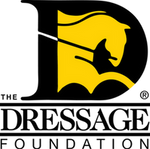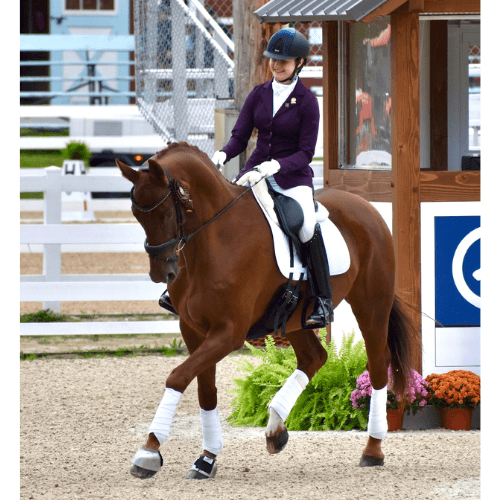
Paige Zimmerman
Day One at the CHIO Aachen:
After two days of travel, today was our first day visiting the iconic Aachen showgrounds! We were lucky to be the first people in line to enter the showgrounds at 8 AM, so we were able to take our time exploring and spectating. Upon arrival, I was immediately mesmerized. As soon as you walk in, your senses perk up to the sights, smells, and sounds of a horse show. It’s truly not like any other show, though, at least no other one that I’ve been to. The closest thing that Aachen reminds me of is Devon, but on a much larger and more electric scale. The rings are all immaculate and the landscaping is beautiful, and the environment is very welcoming, but it feels very, very special. Aachen is definitely a place to revere! There’s palpable excitement in the air, even though all the riders that we watched school in the morning seemed to be calm, collected, and focused, as were the horses.
We met with several people today, including Ali Brock; Swedish team vet Dr. Johan Lenz; Director at the German National Training Center in Warendorf, Markus Scharmann; and Eurodressage owner/operator Astrid Appels! Meeting such a wide range of professionals right on the first day of our visit was very interesting, since we could then watch the rides and warmups while recalling what we’d discussed with each person. Speaking to all these people who have slightly different roles in horse sport was also eye-opening, especially since each one sees horse sport through a different lens than the other, but their ideas and thoughts often overlap.
For example, a big piece of advice that they all gave to us (perhaps in slightly different wording with each person) is to remain authentic to ourselves and to our horses, to take a horse-first approach in training, and to remain curious about the training process and work to truly understand the ‘why’ to every aid. Being able to get deep into the weeds about the training process and understand how it all works, plus understanding the ultimate goals, is healthy for horse, rider, and for horse sport as a whole.
We discussed with each person where they think the sport is headed, and what they would change about it if they could. A common answer amongst them is that harmony and welfare are on the minds of every single stakeholder in equestrian sport. The judging is changing, the rules are changing, and the metaphorical pendulum is going to swing back and forth a bit before it settles and horse sport finds a better place in terms of promoting welfare, harmony, and shining a brighter spotlight on the inherent benefits of excellent riding (for the horse both mentally and physically, as well as creating that special relationship between horse and rider).
It’s important to be true to ourselves and true to our horses so that we can be ahead of the game and prepared to analyze our own riding, seek to improve as we gather more information, and learn to help our horses become the best they can be. This is all a part of the journey of dressage, but especially now as the sport is approaching a turning point and the ground shifts below our feet.
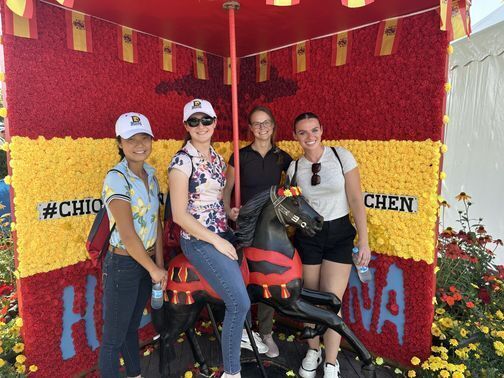
Day Two:
We spent most of our second day at the Aachen showgrounds watching the CDI5* Nations Cup Grand Prix class with our chaperones, JJ Tate and Richard Malmgren. The class was full of fascinating rides and inspiring moments, but one test that particularly stood out was Belgian rider Justin Verboomen’s ride on the stallion Zonik Plus. The entire ride was massively powerful, balanced, and right on the knife’s edge of too much—yet it never tipped over. It was a brilliant example of harmonious riding that maintained tremendous power without any negative tension.
The test was filled with solid 8s, and the horse looked like an incredibly willing and happy partner. You could clearly see the strong connection between Justin and Zonik; they worked seamlessly together. Moments like that make you feel inspired and proud to be part of the dressage world. After his final salute, the crowd erupted—the loudest cheers of the day by far. And when the score came up, showing he had narrowly missed beating the German rider in first place, the crowd actually groaned! That has to be the mark of a truly excellent ride—when even the German audience wishes the Belgian rider had won.
Zonik Plus is still quite young, so it will be very exciting to watch his development over the coming years and see how Justin manages him as they continue their Grand Prix career.
One especially insightful moment from today came during our meeting with Christine Traurig, U.S. Team Technical Advisor and Development Coach. A quote from her that really resonated with me was: “Riding is equestrian academic knowledge implemented with common sense and feel.”
I thought this was such a fantastic way to describe all facets of equestrian sport. It highlights the complexity of what we do: understanding the theory behind training, developing the physical skills needed to apply that knowledge, and cultivating the feel necessary for true harmony with the horse. These elements must all work together, and as riders, we’re always striving toward that elusive balance.
That quote has stayed with me because it perfectly sums up what riding is all about. And what I especially appreciated is that it’s not just dressage-specific—it applies to all types of horse training. Christine shared many great insights, but that line has been echoing in my mind ever since our conversation. It’s simple, yet all-encompassing.
I really enjoyed speaking with her; she was open, engaging, and incredibly generous with her knowledge from the very beginning of our discussion.
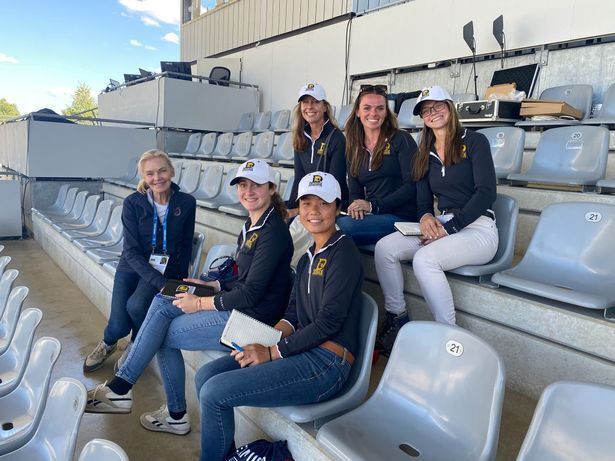
Chatting with Christine Traurig
Day Three:
Today was a jam-packed day of insightful discussions! We had the opportunity to meet with Swedish team members Tinne Vilhelmson-Silfvén and Caroline Darcourt, FEI judge Janet Foy, longtime supporter and sponsor of TDF’s Dream Program Margaret Duprey, Michael Klimke—son of Reiner Klimke and an FEI trainer/competitor—and British team member Becky Moody.
Each conversation offered incredible insights, and a common theme emerged: the need for greater unity within the dressage community. Across the board, everyone emphasized the importance of bringing together riders, judges, vets, and all stakeholders to openly discuss key issues and align on the sport’s evolving changes.
Right now, the pendulum is swinging. As we've learned, there are many changes underway aimed at promoting more harmonious riding and improving horse welfare. With these changes, however, come growing pains. For example, if judging standards shift, it can be difficult for riders to adapt—creating tension across stakeholder groups. Everyone reminded us that meaningful progress doesn’t happen overnight, and it will take time before there’s more clarity and consistency across the sport.
Above all, each person we spoke with brought us back to the heart of dressage: the love of the horse. That love drives our efforts to make the sport better—for the horses, and for the people who care for and train them. At the core of all the changes and challenges is a shared goal: to improve the quality of life for our equine partners and build strong, respectful relationships with them. That truth must remain front and center in how we practice and promote dressage.
One concept that really stuck with me today is how difficult it can be to explain horse sport to those outside of it. Often, people cling to black-and-white beliefs like “every horse should be outside 24/7” without understanding the individuality of horses. But once someone begins to realize that different horses have different needs—some may prefer daytime turnout, others nighttime—it becomes easier to see the beauty of horse sport.
Recognizing the uniqueness of each horse, the variety of training styles, and the deep partnerships that form between horse and rider highlights the heart of dressage: working in harmony. This relationship is symbiotic—when horses thrive, riders often experience improved mental and physical well-being as well. I know I’ve felt that personally!
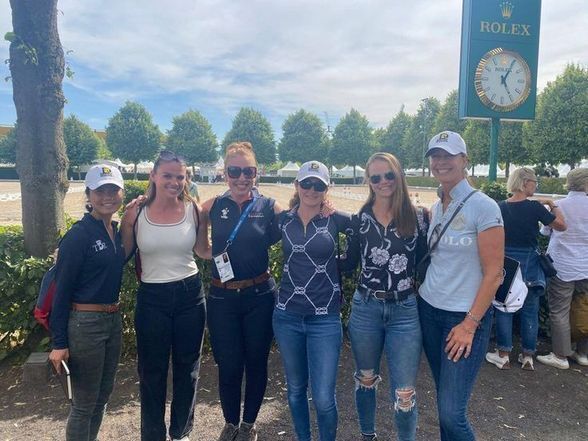
Meeting with Olympian Becky Moody
Day Four:
This morning we watched the CDI5* Grand Prix Special, and what a nail-biter it was! The final rides were especially intense, with the top placings coming down to the wire. In the end, Justin Verboomen took the win, Isabell Werth finished a close second, and Becky Moody placed third. We were all on the edge of our seats. Watching Justin clinch the top spot was thrilling. Becky Moody’s ride with Jagerbomb was also particularly inspiring, especially after hearing her story yesterday. She bred him and brought him along to this point, all through his young horse years (in which she said he was rather unremarkable), and now to international Grand Prix. It gives me chills to think about how perfectly that journey developed. There’s something incredibly special about a partnership that’s been there since day one.
Becky’s story resonates deeply with me. It shows how powerful it can be to put yourself in the right place at the right time, to commit fully, and to stick with your horse through thick and thin. However, as Becky mentioned to us, there is a lot of risk and a lot of trial and error in journeys like this. She explained that she’d brought more than six horses to the Grand Prix Level, and that learning with every horse set her up for the next one. You have to play the long game in order to get an education like that. It can take a lifetime or more for the right horse to come at the right time in your journey and your education, especially if you’re looking toward the international Grand Prix.
Regarding my own goals, after watching these rides here at Aachen and hearing Becky’s story firsthand, I’m more committed than ever to following a similar path toward international competition: by dedicating myself to learning to develop horses with patience, purpose, and good basics, and perhaps one day the stars will align for me too.
Today we also had the opportunity to speak with US Team rider Kasey Perry-Glass and Dutch international Grand Prix rider Dinja van Liere. Both expressed a strong sense of optimism for the future of dressage, which echoed what we’ve all been feeling throughout the show here in Aachen. Kasey shared that this year, she felt a noticeable shift toward more harmonious riding across the board. She emphasized the importance of transparency in our sport, and that riders shouldn’t be afraid to step into big arenas with many eyes watching, because if our training is correct and ethical, there’s nothing to hide. She said that the positive evolution of dressage depends on each of us doing the work to ride in a way that honors the horse and supports the sport's future.
Dinja spoke about the need to stay committed to correct training, especially in times when public scrutiny intensifies. Instead of reacting impulsively to pressure or trends, she advocates for evidence-based approaches and research. She hopes to see research and data used to guide all of us. What struck me most from both conversations was their shared conviction. Staying true to your values, trusting in your training, and always striving to become a better horseperson is what keeps us going and keeps the sport alive!
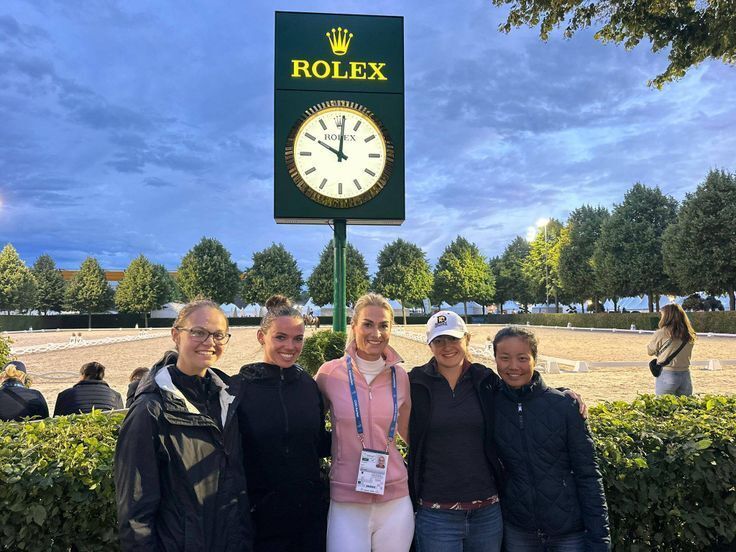
Meeting Dutch Team rider, Dinja van Liere
Day Five:
Today, we had the opportunity to meet with US Team member Marcus Orlob, the one and only Ingrid Klimke, German coach and master Hubertus Schmidt, and US Dressage coach and former USDF President (amongst many additional titles) George Williams.
The theme of the day when speaking to all of these incredibly knowledgeable riders and trainers seemed to be summed up best with this quote from Hubertus: “Something you should never compromise in your training is to make compromises.” You always need to be looking for the horse to develop the correct basics such as willingness to go forward into the hand and maintaining suppleness throughout the body, but sometimes if things are not working out on a certain day, or if an exercise isn’t succeeding, you can make compromises and work with the horse to find a better way to accomplish what you’re seeking.
Ingrid explained that you always have to analyze how your horse feels each day so that you can make the best training decisions. Sometimes if you want to work on an exercise like half-pass, for example, but it’s not going well or doesn’t feel right, there’s no harm in trying something else or making a new plan instead. Speaking with Ingrid was such a very special opportunity! It was so exciting to meet one of my heroes in real life after being able to watch her rides! I can’t wait to attend her masterclass at Dressage at Devon this year.
After our meetings, we spent much of the morning watching the penultimate CDI5* Grand Prix Freestyle class. The music and riding were certainly top-notch, and we saw a lot of excellent harmonious riding and very fun choreography. Something unique to this show that I’ve noticed throughout the week, and especially today, is the level of education that the crowd has. For example, whenever there’s a small mistake that might not be very obvious, such as a flying change that’s slightly close behind, it seems like the entire crowd murmurs. I’ve never felt or seen this phenomenon before, understandably so as I’ve never been to such a large competition before, but it seems like the crowd here at Aachen lives and breathes horse sport. They notice the tiniest mistake, groan at unfortunate blips, and gasp at beautiful moments. Reacting in unison with the crowd is certainly a special feeling of community!
During the freestyles, one rider was going down the centerline to halt and salute, and the crowd began to clap in time with the music just as we had for prior riders. The horse unfortunately spooked and the crowd immediately quieted, waiting to clap until after the rider saluted. Then, for the following rider, we all clapped much more quietly, building up as we could tell that this horse was not bothered by the clapping like the last horse was. It truly shows how the culture here in Germany is so educated, being able to read a horse’s body language to determine whether or not it’s the right time to clap along to the music without risk of scaring the horse!
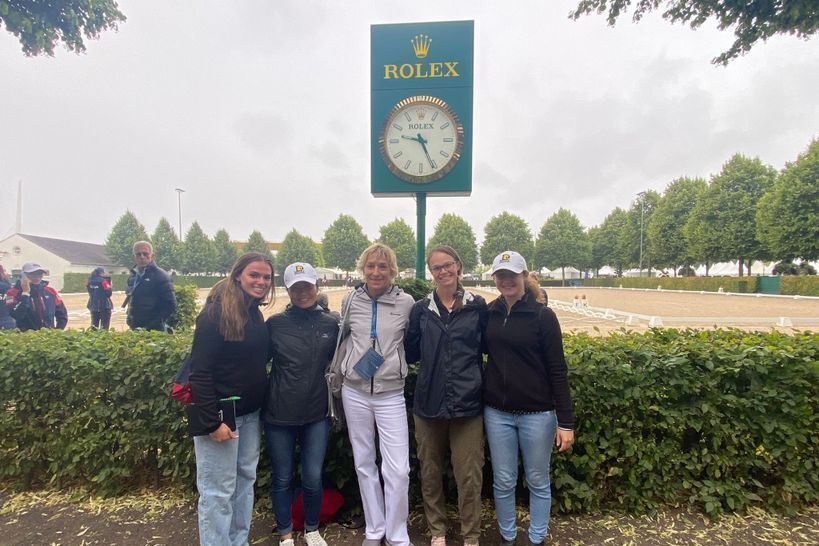
With Ingrid Klimke
Paige's Wrap-Up:
This trip was truly life-changing in so many ways. It was the first time I’d ever traveled internationally and getting that experience was invaluable. At the show itself, it was the first time I’d ever been at an event that was so immersed in horse sport, where the culture celebrates the love of horses to such a high degree!
There’s truly no show like Aachen, it was incredible to be surrounded by the world’s best riders and horses in a wide range of disciplines, whether that be dressage, eventing, jumping, combined driving, and more. Watching them warm up, school, and compete was truly fascinating and such a great learning experience, as we can bring their exercises and techniques into our own riding. Learning by watching is an incredible tool that I use very often, since using the power of visualization to really help to develop your own feel improves your understanding of the horse and the aids.
Also, getting to speak with some of these riders, as well as countless other trainers, competitors, and professionals was so eye-opening and educational. I’ve taken a ton of notes and I have so many thoughts in my head that I could write a book!! Here are some of my largest takeaways from what we learned in our interviews, meetings, and personal observations:
- Learning to develop young horses to the FEI is a skill that is extremely important for the survival of our sport and the future of our teams (in the US) on an international scale. As we saw with Justin Verboomen and Becky Moody, developing a partnership with a horse from the very beginning creates such strong relationships that can bring you all the way to the top of the sport while maintaining true harmony.
- In Germany, young riders can participate in vocational schools for riding and earn a small salary on the way to becoming bereiters. Germany also has a system for certifying trainers, plus requirements for riders to go through each level of dressage, so that they can’t jump up too many levels at once. In the US, we have no such system, and therefore as individuals we must be dedicated to educating ourselves in our riding if we want to compete with the strong foundational system that’s developing fantastic riders and trainers in Germany.
- Dressage is in a state of change, and the metaphorical pendulum is swinging. Harmonious riding is being rewarded, and welfare is on the minds of all. Rule changes and other regulation modifications might be uncertain currently, but this mindset is bringing about a lot of positive changes in dressage. Eventually the pendulum will become still, and we will find balance. Be optimistic and prepared for the future with more harmonious riding!
- Dressage needs transparency. We cannot hide from the public eye, even in times of scrutiny. We cannot be scared to go out and show the world harmonious riding and fabulous partnerships between horse and rider. We can work with the public to show the benefits of dressage for both horse and rider.
- The love of the horse will always prevail!
Thank you to The Dressage Foundation, Margaret Duprey, and all of the other donors for making this trip possible. Thank you to JJ and Richard for helping us through the trip, mentoring us, and facilitating all of our meetings with so many top judges, trainers, competitors, and leaders in our sport. This was an amazing week and I learned so much that I couldn’t have learned without having the opportunity to go on this trip. I’m more dedicated and inspired than ever to learn to ride the best I can, and shoot for the stars, in hopes that someday I can show at Aachen on the US Team!
